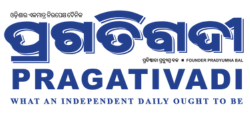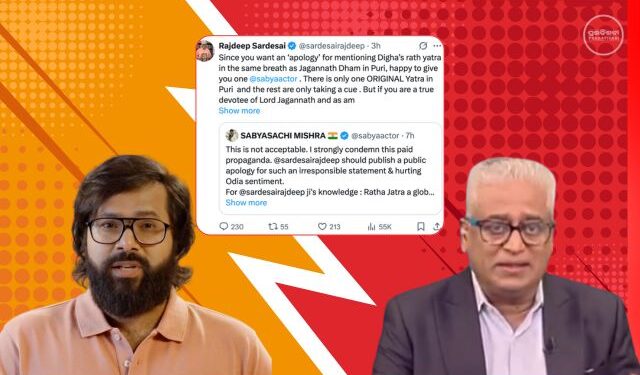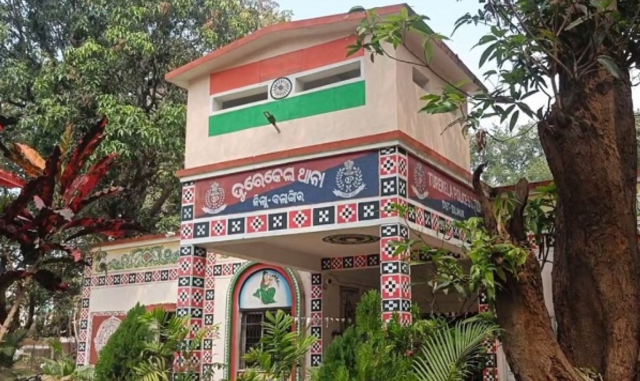The annual Rath Yatra, one of Hinduism’s most revered festivals, took centre stage this week, drawing millions of devotees to Puri, Odisha, and marking the inaugural celebration in Digha, West Bengal. However, what should have been a unifying spiritual event has spiralled into a contentious debate, fueled by a social media post from senior journalist Rajdeep Sardesai. His remarks comparing the sacred Puri Rath Yatra to Digha’s newly launched event have ignited outrage among devotees and cultural custodians, prompting an apology that has only deepened the controversy.
The Rath Yatra, celebrated with grandeur in Puri since the 12th century, saw its 2025 edition marred by logistical challenges. On June 27, over 700 devotees were injured due to delays in chariot manoeuvring and inadequate crowd management. The event, which draws lakhs to witness the procession of Lord Jagannath, Lord Balabhadra, and Devi Subhadra, is steeped in tradition, with its rituals documented in ancient texts like the Skanda Purana. This year, the chaos underscored the need for better planning, a concern echoed by local authorities managing an estimated 10-12 lakh attendees.
Meanwhile, Digha’s first-ever Rath Yatra, inaugurated by West Bengal Chief Minister Mamata Banerjee on the same day, aimed to replicate Puri’s spiritual fervour. The ₹250-crore Jagannath Temple in Digha, a modern construction, hosted a smaller procession, drawing thousands. However, the event’s political undertones—backed by the Trinamool Congress (TMC)—have raised eyebrows, especially given opposition from the Bharatiya Janata Party (BJP), which criticised the temple’s branding as “Jagannath Dham,” a title reserved for Puri in Odisha’s cultural lexicon.
The controversy erupted when Sardesai, in a post on June 27, suggested that the Jagannath Yatra now has “two addresses”—Puri as the original and Digha as a new addition. This statement, quoted across threads on X, drew sharp rebuke from figures like actor Sabyasachi Mishra, who called it “paid propaganda” and demanded a public apology for hurting Odia sentiments. The backlash intensified as devotees argued that Puri’s millennia-old sanctity, recognised as a UNESCO intangible cultural heritage, cannot be equated with Digha’s nascent imitation.
On June 28, at 11:15 AM IST, Sardesai issued an apology via X, addressing Mishra directly. He acknowledged Puri as the “ORIGINAL and MOST SACRED” site while suggesting that the spread of Jagannath devotion to places like Digha should be celebrated. He also referenced the Puri injuries—over 500 reported—to urge better crowd management, a move some interpreted as deflecting blame. However, the apology failed to pacify critics. Users like
accused Sardesai of a “patronizing Congress-style cover-up,” while
labeled it “sadistic,” pointing to his perceived political bias toward TMC.
The debate taps into broader cultural sensitivities. Historians note that Puri’s Rath Yatra, tied to the Eastern Ganga dynasty’s legacy, symbolises a civilizational cornerstone, unlike Digha’s event, which a 2021 Journal of Religious Studies study suggests is part of over 500 global Jagannath temples inspired by Puri. Yet, Sardesai’s framing risks diluting Puri’s unique status, a concern amplified by political rivalry between Odisha’s BJP-led government and West Bengal’s TMC.
Social media reactions have been fierce. Posts on X, trending under “Rath Yatra Controversy 2025,” show a polarised response—some applauding the global spread of devotion, others decrying a perceived insult to Odisha’s heritage.
As the nine-day festival continues, with the Bahuda Yatra return scheduled, the controversy highlights a delicate balance between tradition, faith, and modern politics.
For now, Sardesai’s apology has done little to heal the rift, leaving devotees and cultural advocates to demand greater respect for Puri’s sacred legacy amid a rapidly evolving religious landscape.
RELATED STORY: Controversy Erupts Over Rath Yatra Remarks! Rajdeep Sardesai Draws Flak, Sabyasachi Mishra Leads Call for Apology




























